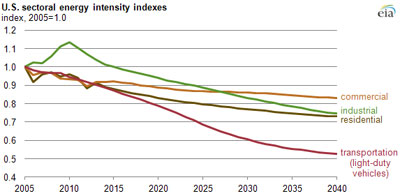Energy efficiency has contributed more to meeting US energy demand than all other resources combined over the past 40 years – more than coal, oil, or nuclear, concludes a report from the Natural Resources Defense Council (NRDC).
In fact, the US has found so many innovative ways to save energy that it has more than doubled economic productivity from oil, natural gas, and electricity over that time.
According to "America’s (Amazingly) Good Energy News," the US used less energy last year than in 1999 and that’s with an economy that grew more than 25% (adjusted for inflation). Factories and businesses are producing substantially more products and value with less energy, the amount of gasoline per mile driven is down, and the cost of all energy services -from lighting to refrigeration – has decreased.
"Our home appliances and electronics have been meeting increasingly tough federal efficiency standards. Remarkable, when you consider not only how many more people are using electricity, but how many more gadgets we have at home now that we did at the turn of the century, how many more chargers are plugged into every wall socket," says Peter Lehner of NRDC.
"Refrigerators are bigger and fancier than ever, yet they use about one-quarter the energy they did 40 years ago, while the cost of owning and operating a fridge has fallen about 70%", he notes.

Because increasing efficiency is far less costly than adding other energy resources like fossil fuels, this is saving the nation hundreds of billions of dollars a year, while helping the US compete worldwide.
Most importantly, these positive trends are substantially reducing the carbon footprint of the US, which is on track to meet President Obama’s target of a 17% cut in carbon emissions by 2020 (from 2005 levels). These trends must continue and accelerate to prevent cataclysmic climate change.
"The US is getting more getting more out of every energy dollar," says Ralph Cavanagh, who co-directs NRDC’s energy program. "But you’d never know it from those who want to build the massive KXL pipeline, ratchet up oil and gas drilling, launch a nuclear renaissance or embrace an ‘all of the above’ energy policy."
Some highlights:
Electricity: Since 2000, for the first time in modern history, the rate of growth in electricity use has dropped well below the rate of population growth.
Oil: The amount of oil used in US vehicles, homes, and businesses continued an extended decline last year, down 14% from a 2005 peak and lower than in 1973 (when the economy was a third smaller).
Coal: Last year, the US used less coal than in 1985, dropping almost 25% from a peak in 2005.
Natural Gas: Last year, it rose to more than 30% of electricity generation, but the trend is very sensitive to volatile commodity prices.
Nuclear: Electricity from nuclear is flat and market share is below 19% of US electricity, down 5% from its peak five years ago.
Renewable energy: Wind led both fossil fuels and other renewables in new generating capacity last year. Wind generated electricity is up 24-fold since 2000.
Energy Efficiency: Energy efficiency standards and financial incentives, underwritten mostly by the utility industry, have dramatically reduced both the energy intensity and costs of energy. And new fuel economy standards are reducing America’s oil imports by more than 2 million barrels per day.
Additional investments in efficiency could further cut US energy consumption by 23% by 2020, saving citizens nearly $700 billion, and creating up to 900,000 direct jobs.
How to get there? Upgrading homes and businesses to make them more efficient; more federal standards that tighten efficiency of buildings, equipment and vehicles; and state policies that make sure utilities have incentives to help customers conserve energy.
"The report is a powerful rebuttal of the ill-considered ‘all of the above’ energy philosophy, which is both unaffordable and environmentally irresponsible," says Cavanagh. "We should learn from 40 years of economy-wide demonstrations that the fastest, cheapest, and cleanest energy solutions all involve getting more work out of less electricity, oil and natural gas."
Read our article, Cities Could Save $70 Trillion Through Energy-Efficient Transportation.
Here’s the report:

 Loading...
Loading...
There is lots of room for improvement, Square Miles in fact. Low profile commercial roofing is more than just a place to install PV, which suffers from still high cost and from conversion inefficiency as well.
That roofing can serve the business beneath that roof better than it can supply the grid. Backing commercial demand off the peak power spike might not interest Utilities, but it has knock on effects for the communities where it is installed. Interestingly, it is a question of bandwidth, but not the sort you’re used to thinking about.